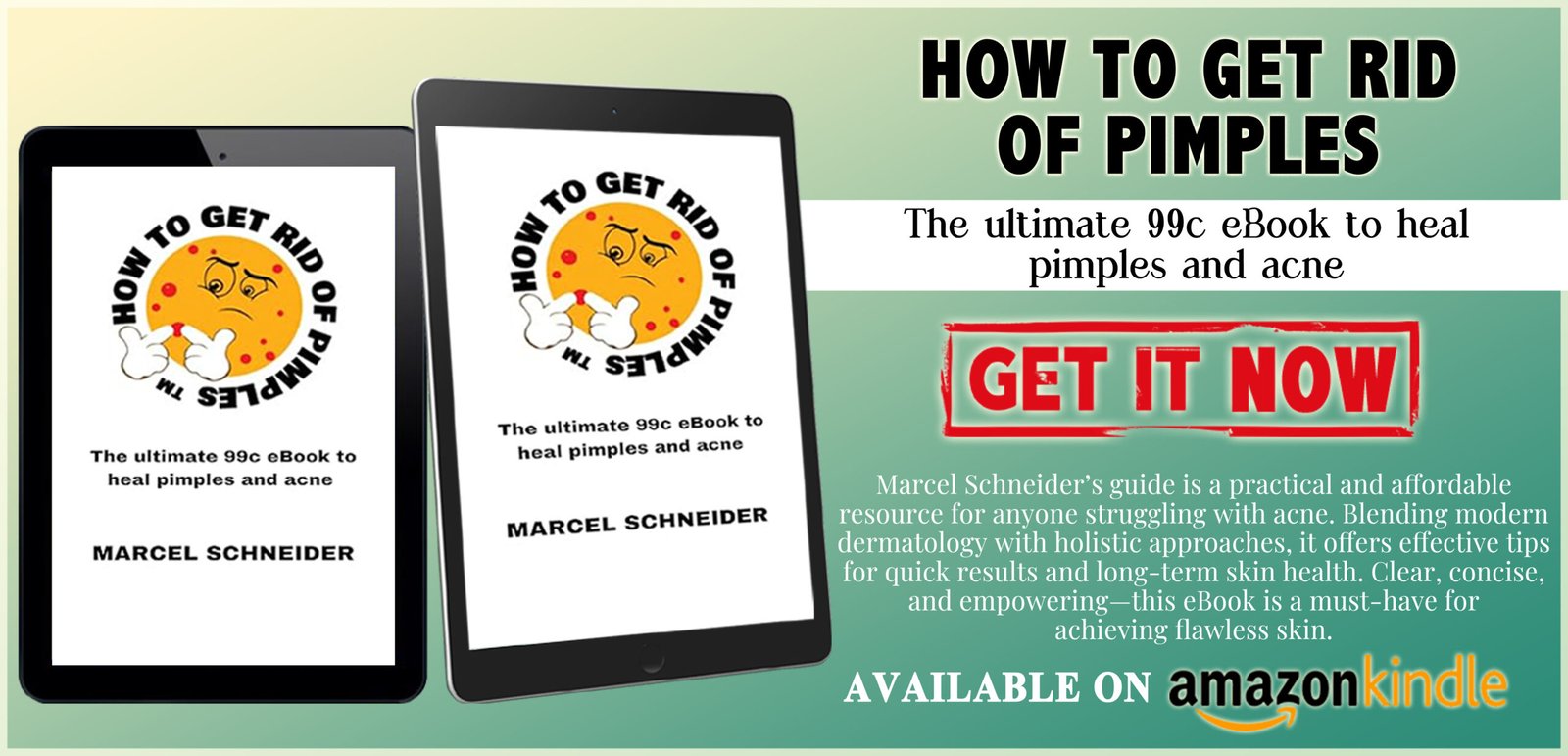Struggling with pimples or acne? Get the solution from the best eBook on the market to heal pimples and acne forever

Introduction
Living with acne can feel like an endless battle. You’ve tried countless products, spent money on expensive treatments, yet those stubborn pimples keep coming back. The mirror becomes a source of frustration, and your confidence takes a hit with each new breakout.
You’re not alone in this struggle. Millions of people worldwide deal with acne, searching for that one solution that will finally clear their skin. The beauty industry offers countless options, but finding what truly works can be overwhelming.
We’ve discovered a game-changing resource: an eBook that stands out in the crowded market of skincare solutions. This comprehensive guide promises permanent relief from acne through:
- Science-backed treatment methods
- Natural healing approaches
- Customizable skincare routines
- Dietary recommendations for clear skin
- Stress management techniques
The best part? This isn’t just another quick-fix promise. The eBook delivers a holistic approach to healing acne from the inside out, addressing the root causes rather than just treating symptoms.
Ready to transform your skin? Let’s dive into what makes this eBook the ultimate resource for anyone struggling with acne. You’ll discover why thousands of readers have found success with its methods and how you can too.
Understanding Acne
Acne develops when hair follicles become clogged with oil and dead skin cells, creating an ideal environment for bacteria to thrive. This common skin condition manifests in several distinct forms:
Types of Acne
- Whiteheads: Closed plugged pores appearing as small, flesh-colored bumps
- Blackheads: Open plugged pores that turn dark due to oxidation
- Papules: Small red, tender bumps
- Pustules: Pimples containing pus at their tips
- Nodules: Large, painful bumps deep under the skin
- Cystic Acne: Deep, painful, pus-filled bumps that can cause scarring
Key Contributing Factors
- Genetic PredispositionFamily history influences sebum production
- Inherited skin cell turnover rates
- Genetic inflammatory responses
- Hormonal ChangesAndrogens increase during puberty
- Menstrual cycle fluctuations
- Pregnancy-related changes
- Polycystic ovary syndrome (PCOS)
- Stress ImpactIncreased cortisol production
- Enhanced sebum production
- Slower wound healing
- Compromised skin barrier function
The Bacterial Connection
P. acnes bacteria plays a crucial role in acne development. These microorganisms:
- Feed on sebum in clogged pores
- Trigger inflammatory responses
- Multiply rapidly in oxygen-poor environments
- Release substances that irritate the skin
Treatment strategies often target these bacteria through:
- Topical antimicrobial agents
- Oral antibiotics
- pH-balancing products
- Oxygen-increasing treatments
The severity of acne varies from person to person, influenced by the complex interaction between these factors. Understanding your specific acne triggers helps determine the most effective treatment approach.
Conventional Treatment Options
Medical professionals offer several proven treatments to combat persistent acne. Let’s explore the most effective options prescribed by dermatologists:
Topical Treatments
- Benzoyl Peroxide (2.5% – 10%): Kills acne-causing bacteria and removes excess oil
- Salicylic Acid (0.5% – 2%): Unclogs pores and reduces inflammation
- Retinoids: Speeds up cell turnover and prevents clogged pores
- Topical Antibiotics: Fights bacterial infection and reduces redness
Oral Medications
- Tetracycline: Reduces inflammation and bacteria growth
- Doxycycline: Treats moderate to severe acne with fewer side effects
- Minocycline: Works effectively against resistant bacteria strains
Advanced Treatment Options
For severe cases that don’t respond to standard treatments, dermatologists might recommend:
Isotretinoin
- Powerful oral medication for cystic acne
- Reduces oil production by 80%
- Requires strict medical supervision
- Treatment duration: 4-6 months
Hormonal Therapies
- Birth control pills containing estrogen
- Spironolactone for hormone-related breakouts
- Particularly effective for women with:
- Chin and jawline acne
- Monthly breakout patterns
- Resistant adult acne
These medical interventions often show significant results within 8-12 weeks of consistent use. Your dermatologist will create a personalized treatment plan based on your acne severity, skin type, and medical history. Regular follow-up appointments help monitor progress and adjust treatments as needed.
Home Remedies for Acne
Nature provides powerful solutions for acne treatment right in your kitchen. These remedies have gained popularity due to their effectiveness and minimal side effects.
1. Tea Tree Oil
- Acts as a natural antimicrobial agent
- Apply diluted (1:9 ratio with carrier oil) directly to affected areas
- Studies show 5% tea tree oil matches benzoyl peroxide effectiveness
- Use twice daily for best results
2. Aloe Vera Gel
- Contains natural salicylic acid and sulfur
- Reduces inflammation and redness
- Speeds up healing process
- Apply fresh gel directly from plant or use pure aloe products
3. Honey and Cinnamon Combination
- Create a paste using equal parts raw honey and cinnamon
- Apply as spot treatment for 10-15 minutes
- Honey’s antibacterial properties fight acne-causing bacteria
- Cinnamon improves blood circulation to affected areas
4. Green Tea Extract Benefits
- Rich in polyphenols and antioxidants
- Reduces sebum production
- Apply cooled green tea as a toner
- Drink 2-3 cups daily for internal benefits
5. Tips for Maximum Effectiveness
- Perform patch tests before applying new remedies
- Start with one remedy at a time
- Document your skin’s response through photos
- Allow 4-6 weeks for visible improvements
- Maintain consistent application schedule
DIY Green Tea Toner Recipe
- Steep 2 green tea bags in 1 cup hot water
- Let cool completely
- Transfer to spray bottle
- Store in refrigerator
- Use morning and night after cleansing
These natural solutions work best when incorporated into a regular skincare routine. Your skin needs time to adjust and respond to new treatments. Combining multiple remedies can enhance their effectiveness – try mixing honey with aloe vera for a powerful healing mask.
Dietary Changes for Better Skin Health
Your diet plays a crucial role in managing acne and maintaining healthy skin. Research shows a direct link between certain foods and acne flare-ups, making dietary modifications an essential part of your skincare journey.
Foods That Trigger Acne
High glycemic index foods spike your blood sugar levels, leading to increased sebum production and inflammation:
- White bread and refined grains
- Sugary snacks and beverages
- Processed foods
- White potatoes
- Milk and dairy products
Skin-Friendly Foods to Include
Adding these nutrient-rich foods can help reduce inflammation and promote clearer skin:
- Omega-3 Rich Foods: Wild-caught salmon, chia seeds, walnuts, flaxseeds
- Antioxidant-Packed Options: Berries (blueberries, strawberries), dark leafy greens, sweet potatoes, tomatoes
- Zinc-Rich Foods: Pumpkin seeds, oysters, lean meats, legumes
The Hydration Factor
Water intake directly affects your skin’s ability to flush out toxins and maintain elasticity. Here’s what you need to know:
- Drink 8-10 glasses of water daily
- Track your intake using a water bottle with time markers
- Include hydrating foods like cucumber and watermelon
- Replace sugary drinks with green tea or infused water
Practical Tips for Implementation
- Start your day with a glass of warm water and lemon
- Keep healthy snacks readily available
- Plan your meals ahead to avoid reaching for processed foods
- Read food labels to identify hidden sugars
- Consider keeping a food diary to track how different foods affect your skin
Remember that dietary changes take time to show results. Combine these modifications with proper skincare routines for optimal results.
Building an Effective Skincare Routine
A well-structured skincare routine forms the foundation of acne-free skin. Let’s break down the essential steps to create your perfect routine:
Gentle Cleansing
- Use lukewarm water – hot water can strip natural oils
- Select pH-balanced cleansers specifically designed for acne-prone skin
- Wash your face twice daily, but avoid over-cleansing
- Pat dry with a clean towel – never rub aggressively
Moisturizing Strategy
- Choose oil-free, non-comedogenic products
- Look for these beneficial ingredients:
- Hyaluronic acid for hydration
- Niacinamide for oil control
- Ceramides for barrier repair
- Apply moisturizer while skin is slightly damp
- Use lightweight gel formulas for better absorption
Products to Avoid
- Alcohol-based toners and astringents
- Heavy, occlusive creams
- Fragranced skincare products
- Physical scrubs with harsh particles
Pro Tips for Success
- Change pillowcases weekly
- Clean phone screens regularly
- Never sleep with makeup on
- Keep hands away from face throughout the day
Treatment Application Order
- Cleanser
- Treatment products (if prescribed)
- Moisturizer
- Sunscreen (during day)
Remember to introduce new products gradually into your routine. Start with a basic three-step system: cleanse, treat, moisturize. Your skin needs time to adjust to new products, so patience is key.
Want to learn more about creating the perfect skincare routine for your acne-prone skin? Our comprehensive eBook provides detailed guides, product recommendations, and expert tips to help you achieve clear, healthy skin.
FAQs (Frequently Asked Questions)
What is the best eBook for healing pimples and acne?
The best eBook on the market claims to provide a permanent solution for healing pimples and acne. It offers comprehensive insights into various treatment options, home remedies, and skincare routines tailored for acne-prone skin.
What are the different types of acne?
Acne can manifest in several forms, including whiteheads, blackheads, and cystic acne. Understanding these types is crucial for effective treatment and management.
What conventional treatments are available for acne?
Conventional treatments include topical options like benzoyl peroxide and salicylic acid, oral medications such as antibiotics (tetracycline and doxycycline), and more severe cases may require isotretinoin or hormonal therapies.
Are there effective home remedies for treating acne?
Yes, popular home remedies like tea tree oil, aloe vera gel, honey with cinnamon, and green tea extract have shown promising results in reducing inflammation and preventing breakouts when used consistently.
How can dietary changes impact skin health?
Dietary changes can significantly influence skin health. Avoiding high glycemic index foods can help reduce acne flare-ups, while incorporating omega-3 fatty acids and antioxidant-rich fruits and vegetables can decrease inflammation from within.
What should be included in an effective skincare routine for acne-prone skin?
An effective skincare routine for acne-prone skin should focus on gentle cleansing methods that do not strip natural oils, using oil-free moisturizers (preferably lightweight gel formulas), and avoiding harsh astringents that may worsen dryness or lead to more breakouts.
